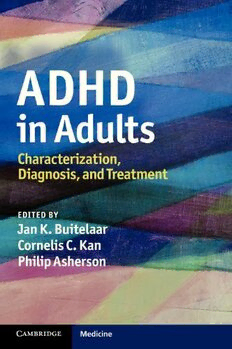
ADHD in adults : characterization, diagnosis, and treatment PDF
Preview ADHD in adults : characterization, diagnosis, and treatment
ADHD in Adults Characterization, Diagnosis, and Treatment ADHD in Adults Characterization, Diagnosis, and Treatment Editedby JanK.Buitelaar CornelisC.Kan PhilipJ.Asherson CAMBRIDGE UNIVERSITY PRESS Cambridge,NewYork,Melbourne,Madrid,CapeTown,Singapore, Sa˜oPaulo,Delhi,Dubai,Tokyo,MexicoCity CambridgeUniversityPress TheEdinburgBuilding,CambridgeCB28RU,UK PublishedintheUnitedStatesofAmericabyCambridgeUniversity Press,NewYork www.cambridge.org Informationonthistitle:www.cambridge. org/9780521864312 (cid:2)c CambridgeUniversityPress2011 Thispublicationisincopyright.Subjecttostatutoryexceptionand totheprovisionsofrelevantcollectivelicensingagreements,no reproductionofanypartmay takeplacewithoutthewrittenpermissionofCambridgeUniversity Press. Firstpublished2011 PrintedintheUnitedKingdomattheUniversityPress,Cambridge AcataloguerecordforthispublicationisavailablefromtheBritish Library LibraryofCongressCataloguinginPublicationdata ADHDinadults:characterization,diagnosis,andtreatment/ editedbyJanK.Buitelaar,CornelisC.Kan,PhilipAsherson. p. cm. Includesbibliographicalreferencesandindex. ISBN978-0-521-86431-2(hardback) 1.Attention-deficitdisorderinadults. I.Buitelaar,JanK., 1953– II.Kan,CornelisC.,1964– III.Asherson,Philip,1960– IV.Title. RC394.A85A343 2010 616.85(cid:3)89–dc22 2010046160 ISBN978-0-521-86431-2Hardback CambridgeUniversityPresshasnoresponsibilityforthe persistenceoraccuracyofURLsforexternalorthird-partyinternet websitesreferredtointhispublication,anddoesnotguaranteethat anycontentonsuchwebsitesis,orwillremain,accurateor appropriate. Everyefforthasbeenmadeinpreparingthisbooktoprovide accurateandup-to-dateinformationwhichisinaccordwith acceptedstandardsandpracticeatthetimeofpublication. Althoughcasehistoriesaredrawnfromactualcases,everyeffort hasbeenmadetodisguisetheidentitiesoftheindividualsinvolved. Nevertheless,theauthors,editorsandpublisherscanmakeno warrantiesthattheinformationcontainedhereinistotallyfree fromerror,notleastbecauseclinicalstandardsareconstantly changingthroughresearchandregulation.Theauthors,editorsand publishersthereforedisclaimallliabilityfordirectorconsequential damagesresultingfromtheuseofmaterialcontainedinthisbook. Readersarestronglyadvisedtopaycarefulattentiontoinformation providedbythemanufacturerofanydrugsorequipmentthatthey plantouse. Contents Listofcontributors vii Preface x Section1–Thedevelopmentof Section3–Assessmentand adultADHDasanepidemiological diagnosisofadultADHD concept 8 DiagnosingADHDinadults 91 LeonardA.AdlerandDavidShaw 1 ThecourseandpersistenceofADHD throughoutthelife-cycle 1 9 Neurocognitivecharacteristicsof JosephBiederman adultswithattention-deficit hyperactivitydisorder 106 2 Theprevalenceandcorrelatesofadult JonathanH.DowsonandAndrew ADHD 9 D.Blackwell RonaldC.Kessler,LeonardA.Adler, RussellBarkley,JosephBiederman, C.KeithConners,LaurenceL.Greenhill, Section4–ComorbiditiesofadultADHD andThomasSpencer 10 AdultADHDandmooddisorders 121 3 GenderdifferencesinADHD 18 ThomasE.Brown PatriciaQuinn 11 Attention-deficithyperactivity disorderandanxietydisordersin Section2–Insightsintothe adults 130 pathophysiologyofADHDinadults MargaretWeiss,ChristopherGibbins,and JuliaD.Hunter 4 Quantitativeandmoleculargenetic 12 Attention-deficithyperactivity studiesofattention-deficit disorderandthesubstanceuse hyperactivitydisorderinadults 25 disorders 138 PhilipJ.Asherson,FlorenceLevy,and TimothyE.Wilens SteveV.Faraone 13 AdultADHDandorganicbrain 5 Structuralandfunctionalmagnetic disorders(includingpsychotic resonanceimagingfindingsinadults symptomsandtics) 151 withADHD 49 AskoNiemela YannisPaloyelisandPhilipJ.Asherson 14 OverlapbetweenADHDandautism 6 Electrophysiologicalstudiesofadult spectrumdisorderinadults 157 ADHD 66 ChristopherGillberg,I.CarinaGillberg, Gra´inneMcLoughlin,JonnaKuntsi,and HenrikAnckarsa¨ter,andMariaRa˚stam PhilipJ.Asherson 15 ADHDinadultswithintellectual 7 Emissiontomographyinadult disabilities 168 ADHD 75 KiriakosXenitidis,EleniPaliokosta, MitulA.MehtaandJohannaKrause VangelisPappas,andJessicaBramham v Contents 16 ADHD,personality,anditsdisorders 174 22 CoachinginADHD 247 FionaE.vanDijkandHenrikAnckarsa¨ter DorisRyffel 23 Clinicalapplicationofresearchon Section5–Pharmacological cognitive-behavioraltherapiesfor adultswithADHD 254 treatmentofadultADHD StephenP.McDermott 17 StimulanttreatmentofadultADHD 191 ThomasSpencerandJosephBiederman Section7–Alternativebiological 18 Theuseofnonstimulantdrugsinthe treatments treatmentofadultADHD 198 WimJ.C.VerbeeckandSiegfriedTuinier 24 Neurofeedbacktrainingforadult ADHD 271 19 Medicationmanagementinadult SeijaSirvio¨andYlvaGinsberg ADHD 218 J.J.SandraKooij 25 Alternativeandcomplementary treatmentsforADHD 278 20 Abusepotentialofstimulantdrugs LacramioaraSpetieandL.EugeneArnold usedtotreatADHD 230 ScottH.Kollins Afterword:ADHDinadults–towarda newdefinitioninDSM-V 297 JanK.Buitelaar Section6–Psychologicaland socialtreatmentstrategiesfor adultADHD Appendix1:Patientorganizationsfor 21 Psychoeducationforadultswith ADHD(countriesinalphabeticalorder) 305 ADHD:Impressionsfromthefield 240 Appendix2:UsefulwebsitesforADHD(in AnneM.D.N.vanLammerenand alphabeticalorder) 308 RichardBruggeman Index 309 vi Contributors LeonardA.Adler JanK.Buitelaar DepartmentsofNeurologyandPsychiatry,NewYork RadboudUniversityNijmegenMedicalCentre, UniversityMedicalCenter,NewYork,NY,USA DepartmentofCognitiveNeuroscienceNijmegen, TheNetherlands HenrikAnckarsa¨ter SeniorConsultant,ForensicPsychiatry,Universities C.KeithConners ofGothenburgandLund,HisingsBacka,Sweden DukeUniversityMedicalCenter,Durham,NC,USA L.EugeneArnold JonathanH.Dowson ProfessorEmeritusofPsychiatry,OhioState UniversityDepartmentofPsychiatry,Addenbrookes University,Sunbury,OH,USA Hospital,Cambridge,UK PhilipJ.Asherson SteveV.Faraone MRCSocial,GeneticandDevelopmentalPsychiatry DepartmentofPsychiatry,HarvardMedicalSchoolat Centre,InstituteofPsychiatry,King’sCollege MassachusettsMentalHealthCenter,Boston,MA, London,London,UK USA RussellBarkley ChristopherGibbins DepartmentofPsychiatry,MedicalUniversityof PsychologistandFellow,ADHDClinic,Children’s SouthCarolina,Charleston,SouthCarolina,USA andWomen’sHealthCentre,BritishColumbia, Canada JosephBiederman DepartmentofPsychiatry,MassachusettsGeneral ChristopherGillberg Hospital,Boston,MA,andDepartmentofPsychiatry, DepartmentofChildandAdolescentPsychiatry, HarvardMedicalSchool,Boston,MA,USA Go¨teborgUniversity,Go¨teborg,Sweden AndrewD.Blackwell I.CarinaGillberg UniversityDepartmentofPsychiatry,Addenbrookes InstituteofChildandYouthPsychiatry,Universityof Hospital,Cambridge,UK Uppsala,andDepartmentofChildandAdolescent Psychiatry,UniversityofGo¨teborg,Sweden JessicaBramham ClinicalPsychologist,AdultADHDService,The YlvaGinsberg MaudsleyHospital,London,UK PsychiatrySouthwest,KarolinskaUniversityHospital, Huddinge,Sweden ThomasE.Brown AssociateDirectoroftheYaleClinicforAttentionand LaurenceL.Greenhill RelatedDisorders,DepartmentofPsychiatry,Yale DivisionofChildandAdolescentPsychiatry, UniversitySchoolofMedicine,NewHaven,CT,USA ColumbiaUniversityandNewYorkStatePsychiatric Institute,NewYork,NY,USA RichardBruggeman UniversityCentreofPsychiatry,UniversityMedical JuliaD.Hunter Centre,UniversityofGroningen,Groningen,The Fellow,ADHDClinic,Children’sandWomen’s Netherlands HealthCentre,BritishColumbia,Canada vii Listofcontributors CornelisC.Kan EleniPaliokosta RadboudUniversityNijmegenMedicalCentre, ConsultantChildandAdolescentPsychiatrist,Adult DepartmentofPsychiatry,Nijmegen,The ADHDService,TheMaudsleyHospital,London,UK Netherlands YannisPaloyelis RonaldC.Kessler MRCSocial,GeneticandDevelopmentalPsychiatry DepartmentofHealthCarePolicy,HarvardMedical Centre,InstituteofPsychiatry,King’sCollegeLondon School,Boston,MA,USA VangelisPappas ScottH.Kollins ConsultantPsychiatrist,IoanninaDistrictGeneral AssistantProfessorandDirector,DukeADHD Hospital,Ioannina,Greece Program,DepartmentofPsychiatryandBehavioral PatriciaQuinn Science,DukeUniversitySchoolofMedicine, DevelopmentalPediatrician,Washington,DC,and Durham,NC,USA ClinicalAssistantProfessorofPediatrics,Georgetown J.J.SandraKooij UniversityMedicalCenter,Washington,DC,USA PsyQ,ProgrammeAdultADHD,TheHague,The MariaRa˚stam Netherlands DepartmentofChildandAdolescentPsychiatry, JohannaKrause Go¨teborgUniversity,Go¨teborg,Sweden OutpatientClinicforPsychiatryandPsychotherapy, DorisRyffel Ottobrunn,Germany Psychiatrist,Bern,Switzerland JonnaKuntsi DavidShaw MRCSocial,GeneticandDevelopmentalPsychiatry DepartmentofPsychiatry,NewYorkUniversity Centre,InstituteofPsychiatry,King’sCollege SchoolofMedicineandPsychiatryService,NewYork London,UK VAHarborHealthcareSystem,NewYork,NY,USA FlorenceLevy SeijaSirvio¨ HeadofChildandFamilyEast,PrinceofWales SpangaPsychiatricUnitforAdults,Stockholm, HospitalandSydneyChildren’sCommunityCentre, Sweden SchoolofPsychiatry,UniversityofNewSouthWales, Sydney,Australia ThomasSpencer StephenP.McDermott AssociateChief,PediatricPsychopharmacologyUnit, MassachusettsGeneralHospital,andAssociate CognitiveTherapyInstitute,CognitiveTherapyand ProfessorofPsychiatry,HarvardMedicalSchool, ResearchProgram,MassachusettsGeneralHospital, Boston,MA,USA HarvardMedicalSchool,Boston,MA,USA LacramioaraSpetie Gra´inneMcLoughlin ChildandAdolescentPsychiatrist,Nationwide MRCSocial,GeneticandDevelopmentalPsychiatry Children’sHospitalDivisionofChildandAdolescent Centre,InstituteofPsychiatry,King’sCollege Psychiatry,Columbus,OH,USA London,UK SiegfriedTuinier MitulA.Mehta ThelateSiegfriedTuinierwasformerlyatVincentvan InstituteofPsychiatryatKing’sCollegeLondon,and GoghInstitute,Venray,TheNetherlands DivisionofNeuroscienceandMentalHealth, ImperialCollege,London,UK FionaE.vanDijk AskoNiemela RadboudUniversityNijmegenMedicalCentre, DepartmentofPsychiatry,Nijmegen,The OuluUniversityHospital,DepartmentofPsychiatry, Netherlands Finland viii Listofcontributors AnneM.D.N.vanLammeren TimothyE.Wilens UniversityCentreofPsychiatry,UniversityMedical Director,SubstanceAbuseServices,Pediatric Centre,Groningen,TheNetherlands PsychopharmacologyClinic,MassachusettsGeneral Hospital,andAssociateProfessorofPsychiatry, WimJ.C.Verbeeck HarvardMedicalSchool,Boston,MA,USA VincentvanGoghInstitute,Venray,TheNetherlands KiriakosXenitidis MargaretWeiss ConsultantPsychiatrist,AdultADHDService,The ClinicalHead,ADHDClinic,Children’sand MaudsleyHospital,London,UK Women’sHealthCentre,BritishColumbia,Canada ix Preface ReviewingadultADHD:Reintegration has been growing (Jaffe, 1995). Several longitudinal follow-up studies convincingly showed that ADHD afterdifferentiation symptomspersistinasignificantproportionofadults Originally, attention-deficit hyperactivity disorder withahistoryofchildhoodADHD(Mannuzzaetal., (ADHD; formerly called minimal brain damage/ 1993, 1997, 1998; Weiss & Hechtman, 1993; Weiss dysfunction) was considered to be a childhood et al., 1985). These studies were important in estab- disorder and was therefore not diagnosed in adults. lishingthatADHDoftenpersistsintoadulthood,with This concept that ADHD was a child-only disorder age-relatedchangesinthewaythatthecharacteristic began to change in the 1970s. For the first time, symptomsofthedisorderpresentinadults. two preliminary reports in 1976 on the nature of The importance of diagnosing ADHD in adults ADHD symptoms and psychosocial impairments was further supported by studies on treatment effi- in adults with a past history of childhood ADHD cacy. Studies undertaken to investigate whether psy- arguedthatADHDmightnotalwaysbeoutgrownin chostimulanttreatmentswereeffectiveinadultswith adulthood.Theauthorsemphasizedmanysimilarities ADHDreportedcomparableeffectsizestothoseseen betweenADHDinchildrenandinadultsinpatterns in children (Arnold, Strobl, & Weisenberg, 1972; of core symptoms and comorbidity, association with Mattes,Boswell,&Oliver,1984;Wender,Reimherr,& impairments and cognitive performance measures, Wood,1981;Wender,Wood,&Reimherr,1985;Wood and response to medication (Hechtman et al., 1976; etal.,1976). Woodetal.,1976). AlandmarkintherecognitionofadultADHDwas Subsequently, in 1980, the category of attention thestudythatdemonstratedsignificantdifferencesin deficit disorder (ADD), residual type, was defined thecerebralglucosemetabolismofadultswithADHD inDSM-III(AmericanPsychiatricAssociation,1980); comparedtocontrolsubjects(Zametkinetal.,1990). this category provided the first opportunity to make Thisstudywasinnovativeintwoways:itappliedthe a formal diagnosis of ADHD in adults with a past newneuroimagingresearchparadigmtoADHD,and historyofADDandpersistingattentionandconcen- itdidsoinasampleofadultsinsteadofchildren.The tration problems, without a requirement of persist- fMRIstudyofBushetal.in1999–thefirsttodemon- inghyperactivitysymptoms.Thisdiagnosticpossibil- strate the absence of inhibitory activity of the ante- ity must have served a purpose in practice, because riorcingulateinADHD–wascarriedoutinadultsas its removal in the DSM-III-R (American Psychiatric well. Association,1987)ledtoarequestfromanumberof In addition to its recognition in clinical practice, researchersandclinicianstorestoreit(Shaffer,1994); adult ADHD has developed into a research field of effortsfollowedtodefineappropriatediagnosticcrite- interestinitsownright.Inthelastdecade,thenum- riaforADHDinadults(Ward,Wender,&Reimherr, berofscientificreportsonadultADHDhasincreased 1993;Wender,1987).AlthoughthecategoryofADD, exponentially,asshowninFigure1. residual type, was not restored in the DSM-IV, the In this exponential growth we also witness an DSM-IVADHDcriteriaweremodifiedinsuchaway increasing differentiation. Investigators are increas- thattheycouldbeappliedmoreeasilytoadults(Amer- ingly focusing and making progress on specific icanPsychiatricAssociation,1994). subtopics with respect to adult ADHD, and it is no Since then, the acceptance of adult ADHD by longereasytooverseetheentirebodyofknowledgeon the professional community and the general public ADHDinadulthood. x
